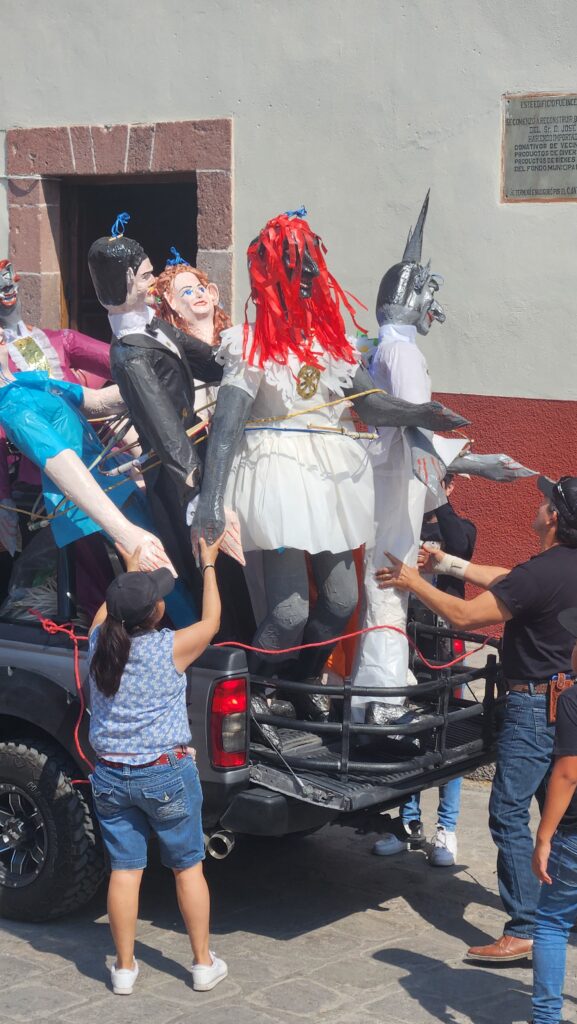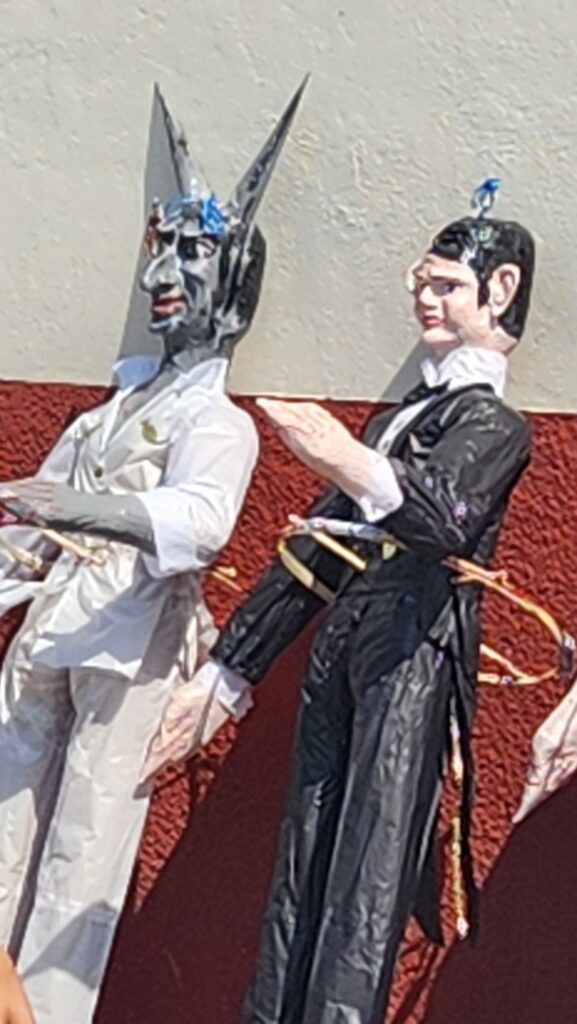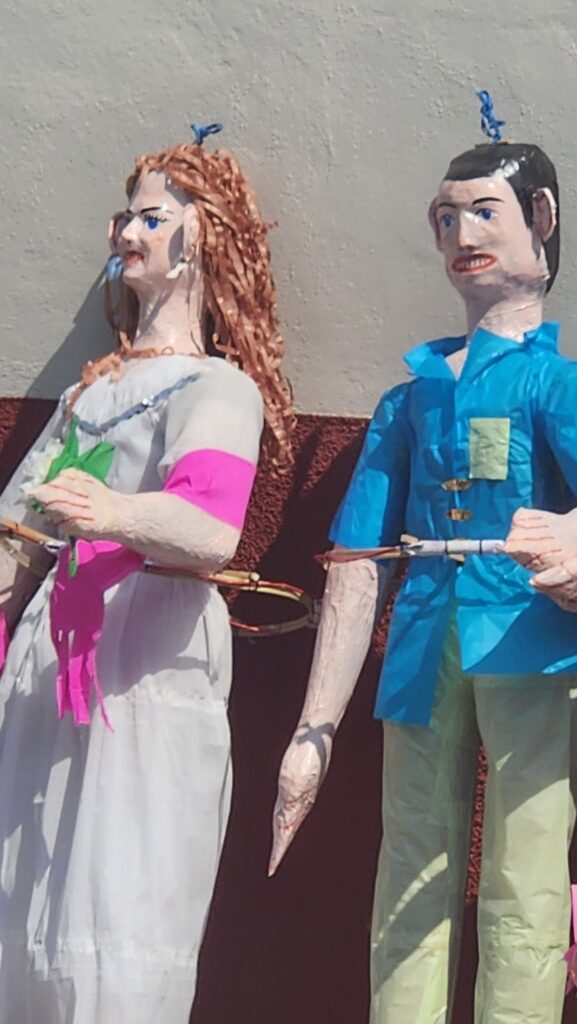Defying the Resistance to the Resistance, the Traditional Quema de Judas Event Lives On
it is the spectators themselves who love the Burning of Judas ceremony, and have actively worked to keep it alive, despite the efforts of various authorities to quash it. Around the world today, each Burning of Judas event has developed its own personality, which reflects the local vibe. Here are 9 Fun Facts that reveal the quirks of the most prominent Burning of Judas events around the world, that 99% of people don’t know.
Fun Fact #1: San Miguel de Allende is the Only Place in the World Where the Burning of Judas Happens on Easter Sunday.
Most Judas burnings in Mexico take place on Easter Saturday at dusk or in the evening, purportedly to give people something to do between the crucifixion ceremonies on Friday and the resurrection rituals on Easter Sunday. San Miguel de Allende stages its Judas burning at 12:00 noon on Easter Sunday itself.
It’s a common joke that the timing of San Miguel’s Burning of Judas is due to its heathen Gringo population which prefers this irreverent tradition outside the church walls to the religious Easter Sunday rituals happening inside San Miguel’s popular Parroquia. It’s probably not true, but the explanation for San Miguel’s break in the traditional timing for the event is not really clear.
Fun Fact #2: In Jerez, Zacatecas, Cowboys on Horseback Compete to Lasso the Judases and Drag Them Down the Street Before They Explode.
Bans on explosives and burnings have been used as the excuse to quash the Quema de Judas tradition in many places in Mexico. But you wouldn’t know that in Jerez, Zacatecas. Not only are the symbolic Judas paper characters hung high in the air, a cavalcade of genuine cowboys (known as charros) on horseback gather in the streets underneath.
After the fuse is lit for the Judas destruction, the cowboys compete to lasso each Judas figure before it explodes. The prize for the skilled cowboy who succeeds is the honor of galloping down the street dragging the lassoed Judas while it continues to explode and destroy itself and the crowd cheers the victorious cowboy on. It’s really a must-see twist that’s captured in the video below.
Fun Fact #3: The Burning of Judas in Santiago, Guanajuato, Has Been a Continuous Tradition for Over 109 Years
The Santiago neighborhood in the state of Guanajuato boasted 109 consecutive years of Burning of Judas ceremonies in 2024. This most recent Judas burning event featured 7 effigies in total. One was a cross, which symbolized all religious-related Judases. Another was a 2-meter (6 1/2 ft.) rat which symbolized all politicians. And the remaining five Judas figures, rather than depicting famous and widely known nefarious personalities, focused on local evildoers. Even the 2024 organizer of the event had once been depicted as one of the town’s Burning Judases in the past.



Fun Fact #4: The Burning of Judas In Puebla, Mexico Has Been Kept Alive by Artists, not the Church.
The Burning of Judas tradition is deeply rooted in religions that believe in the biblical account of the betrayal of Judas of Iscariot. But in Puebla, Mexico, the Quema de Judas ritual has been kept alive by Puebla’s artists. Staged in El Barrio del Artista of Puebla, the Judas effigies are crafted with the traditional materials of reeds and Chinese tissue paper by Artist Neighborhood residents. The paper puppets burned during the Quema de Jesus event in Puebla are no longer religious characters, they are politicians, artists, and even media personalities deemed to be modern-day “betrayers.” It’s not just the performance art aspect of the event that motivates the organizers in the Artist’s neighborhood to keep the tradition alive. They also admit that they are happy to have the publicity and the extra foot traffic that the event creates for them.
Fun Fact #5: The Burning of Judas Has Become Devil Day in El Doctor, Cadereyta de Montes (outside Queretaro).
Easter Saturday in El Doctor, Cadereyta de Montes, the Burning of Judas is no longer just a brief ceremony, it is an all-day celebration. People of all ages join in the event by wearing devil masks that they handcrafted out of wood or clay. These “devils” then march together in a “Devils through the streets” parade. After sundown a traditional Quema de Judas (Burning of Judas) is staged, followed by a huge devil dance which ends festivities on a musical and energetic note.
Fun Fact #6: Mexico City Allows Judas to Burn in the Barrios, But Doesn’t Embrace the Ritual as a Central Large-Scale Event.
In Mexico City, the tradition is alive in many different barrios on Easter Saturday, exemplified by events such as the Cartonería Festival and the Festival of Traditions at the Dolores Olmedo Museum. The most bizarre tradition happens in the Coyoacán neighborhood of Mexico City. Here eyewitnesses report that approximately 30 men dressed in Judas costumes prowl the neighborhood and mete out whippings to any men they can find. The Judas gangs have been known to drag men out of stores and into the streets in order to whip them. The “whippings” are meant to be symbolic, not punishing, but the whipped report that some of the Judases are more violent than others. The Judases attacking the people is actually the opposite of the Burning of Judas intent, so this Coyoacán tradition is very bizarre indeed!



Fun Fact #7: In San Luis Potosi the Burning of Judas Is a Government Sponsored Art Contest Before It Is an Explosive Public Spectacle.
In San Luis Potosi, rather than trying to stifle the Burning of the Judas tradition, the Executive Branch of the State of San Luis Potosí through the Ministry of Culture, and the National Mask Museum, is promoting the annual Burning of the Judas as an artisan activity. The citizens of San Luis Potosi are invited to participate in the XXIX Judas 2024 Making and Burning Contest. There were 32 entries submitted in 2024 and the winners in two different categories were awarded MXN$13,000.00 for First Place, MXN$10,000.00 for Second Place, and MXN$8,000.00 for Third Place.
All 32 of the entries – including the winners – were burned at the National Mask Museum, making the San Luis Potosi the largest in the world, in terms of the number of Judas effigies who met their fiery demise.
Since the San Luis Potosi Burning of the Judas events are sponsored by the San Luis Potosi government, communication about the event include a disclaimer that this activity is unrelated to any specific interest or political party, in an effort to keep the spirit of the event unifying, not polarizing.
Fun Fact #8: In Ermioni, Greece, Judas is Burned on a Raft, Surrounded by a Flotilla of Spectator Boats.
This Burning of Judas tradition, however, is not exclusive to Mexico. It originated in Europe during the Middle Ages and didn’t arrive in North America until the Spanish conquest. It’s difficult to find Judas Burning events outside of Mexico these days, but there are still some notable global events.
Although the Burning of Judas ritual is centuries old, in Ermioni, Greece it is a relatively recent addition to their Easter celebrations. The Greek twist to the ceremony is that it all takes place on water, not land. Residents and visitors gather in boats, creating a flotilla that moves out onto the water. Then the floating participants launch a raft carrying a larger than life wire effigy of Judas and set the whole thing on fire.
Fun Fact #9: The Burning of Judas in Venezuela Is Not a Lighthearted Cultural Event, But a Serious Political Protest.
In Venezuela, the Burning of Judas transcends tradition to become a bonafide political protest. Particularly in 2023, the event had a completely serious tone, with effigies representing prominent corrupt political figures being burned in the streets. In Barquisimeto, Lara state, an effigy resembling President Nicolas Maduro was set ablaze, while in Caracas, a three-headed snake effigy symbolizing all corrupt public officials, which some Venezuelans believe all public officials to be, was set on fire. Unlike the controlled explosions in San Miguel de Allende and other places, the Burning of Judas in Venezuela most recently has created towering bonfires, which send a much more intense and serious message.
The Judas Tradition Continues to Burn Bright In San Miguel de Allende and Beyond
With today’s Burning of Judas events, there’s a spark of mischief, a dash of defiance, and an irreverent tradition that refuses to be snuffed out. The best efforts of authorities to dampen the spirits of this age-old ritual have only fueled the fires. Because the resistance to the resistance is exactly what the fuss is all about. Just like so many one-of-a-kind traditions in San Miguel de Allende, the Burning of Judas continues to burn bright because of the heart and soul of the people who have kept them alive for many generations.






I had never heard of this before but I like to learn about age-old rituals and this one sounds very interesting. Hopefully, I can attend one one day.
I had never heard of Burning of Judas either until I visited San Miguel de Allende. This little city loves to celebrate in every way possible and they do it well!
Wow, I had no idea this existed! It’s so cool that different neighborhoods have continued this tradition in ever evolving ways.
Agreed! Sometimes “tradition” limits creativity, but definitely not with this crazy Burning of Judas ritual!
I had no idea about this tradition, but I love unusual things like this! Putting this on my bucket list to attend one day.
It’s a truly obscure tradition and SO worth thee trip to participate in it!
Oh this is so fascinating! I’ve seen videos of the event before but had no idea that San Miguel de Allende is the only place in the world that is takes place.
Not the only place… but certainly San Miguel de Allende is one of the biggest and most well-organized Burning of Judas ceremonies!
Wow, nice knowing this, I totally had no idea. I’d love to visit Mexico.
Mexico is fantastico! Did you know that San Miguel de Allende is one of the best small cities in the world according to Conde Nast readers? It has been on that list for MANY years in a row!
In Yanahuara (near Arequipa, Peru), they burn Judas on Good Friday of Semana Santa (Holy/Easter Week).
YAY! Thank you for telling me that. I’m going to do some research and add that to the article!
I would love to experience one of these events at least once in my lifetime. Thank you for sharing!
San Miguel events are definitely worth the effort. SO unique and so authentic!